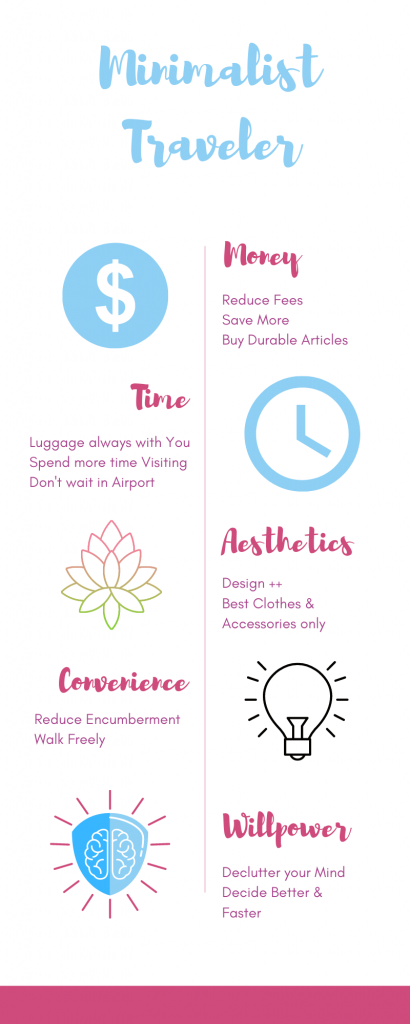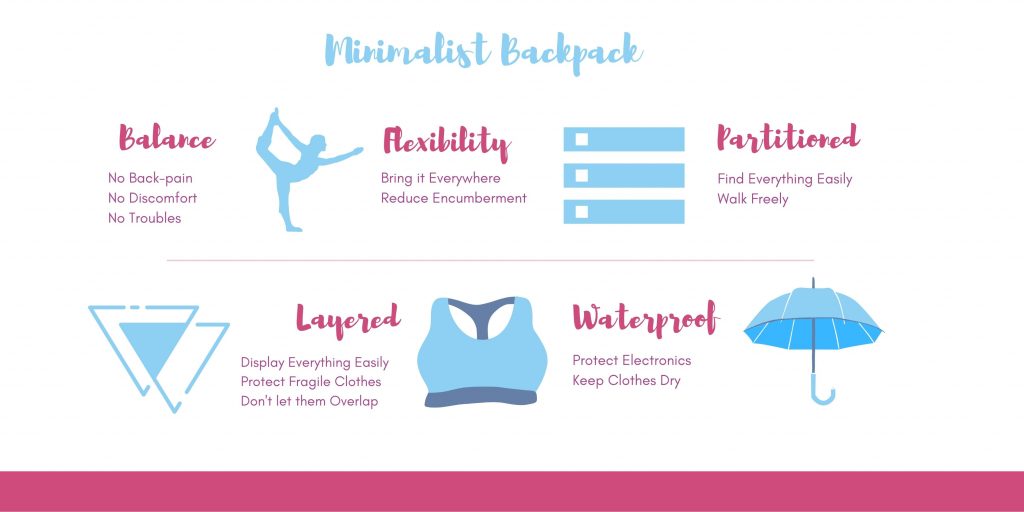- Why would you want to take less things with you?
- What if you miss something?
- You would do it for yourself, but as a large group there’s no way you could bring so few things.
- Where should you start?
This is where you should start:
- There will be a reason for you.
- More Health
- More Money/Space
- More Time/Experiences/Convenience
- More Aesthetic
- More Less
- More Willpower
- Your Minimalist Backpack
- Clothes
- Electronics
- 1st aid kit
- Hygiene products
Minimalist Traveling – Why?

1st thing : Book at a great hotel.
You’ll need some services like laundry, good hygiene products,
- Do you want more Space?
- Less luggage.
- Do you want a more Healthy travel?
- Physical efforts can affect your anxiety by enhancing your cortisol levels.
- These physiological changes express themselves through spikes in your Body Temperature.
- All this weight pressures your Articulations.
- Same for your Spine & your Back in general.
- Do you want more Money?
- Bringing less things will diminish the luggage fee.
- Buy less items, more expensive one, and quality-wise you’ll win.
- Less possessions, more durability.
- Buy what you really want
- Do you want more Time?
- Do you want more Experiences, more Convenience?
- Traveling is a transformative experience.
- You don’t want to waste a 5th of your day waiting for your luggage.
- As you always keep it with you diminish the risk of loss or theft.
- It becomes easier, or least quicker, to go through airport security.
- And even more so through Customs.
- Then go out and visit more.
- Do you want more Aesthetic?
- You’ll look less clumsy with only 1 bag.
- It helps you to limit your choice to your best clothes.
- Minimalism cultivates your sens of design.
- Do you want more Less?
- You may have began minimalism because you realized you needed less things.
- No Binge Shopping.
- Walk your way to what’s essential.
- You don’t need to change your towel everyday.
- You don’t need your own shampoo/conditionner.
- Do you want more Willpower?
- Minimalism is the way to resilience.
- Declutter your mind for better & faster decisions.
- Not influenced by travel’s ambiance from the airport to the theme park.
- Travel more responsibly.
- Consume conscientiously
- Less pollution (chemical, audio, physical)
Your Minimalist Backpack
How to choose it?
- Not bigger than your back.
- Pick a bag that allows you to keep your balance through proper weight distribution.
- Ergonomic for walking and taking public transport.
- Its Volume should be around 30-40 liters.
- Preferably made of waterproof sailcloth.
- Conveniently partitioned to find your tools easily.
- Do you need a day-pack?
- An additional bag to bring what you’ll need for the day.
- Useful if you travel as a family
- If you’re really into minimalism your day-pack may become your definitive backpack.
What’s inside?
- Pack only essential items for one week.
- Book in a hotel with a laundry service, or look for a reliable one in your vicinity.
- Wear your jacket/vest or shoes to save even more room.
- Choose durable fabrics & simple colors.
Travel Lightweight for a week:
- Clothes
- 2 Jeans/Skirts
- 3 Dress/Shirts
- 1 Vest/Jacket
- Underwear/Socks 1 per day
- 1 pair of Shoes
- Glasses/Sunglasses
- Electronics
- Laptop/Tablet/Camera
- Chargers/Headphones
- External HDD/SSD – opt for a 512GB flash drive for more space
- Wallet
- ID Cards/Driver Licence, Cash(100$)
- In-Emergency Contact Card / Embassy Contact
- Health
- Mini 1st Aid Kit
- Important medical papers
- Reusable Water bottle/Water Purifier Bottle
- Contraceptive pills + Condoms
- Hygiene products
- Tampons
- Toothbrush + paste + floss
- Razors + razorblade





















